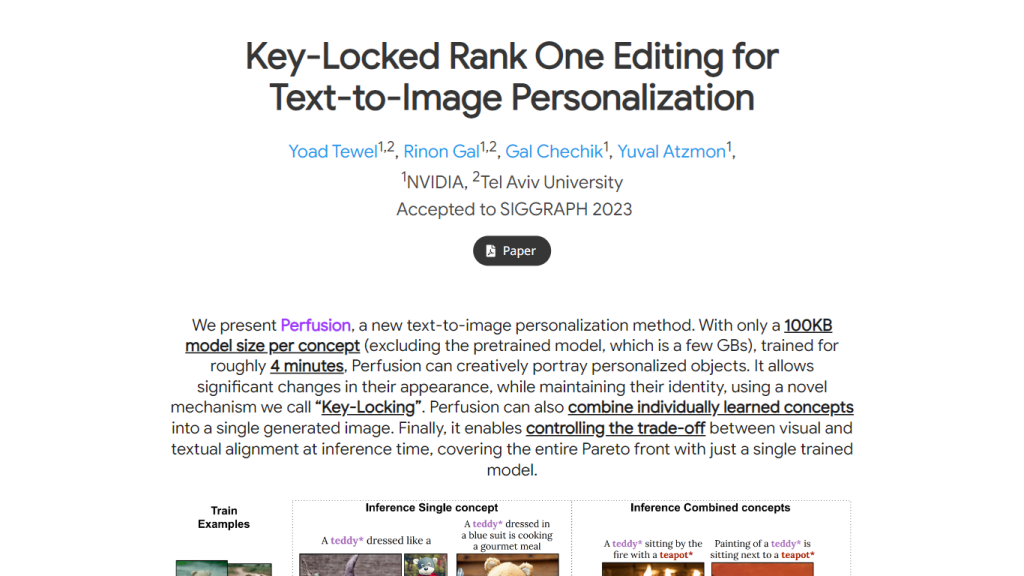What is Perfusion?
Perfusion is a new text-to-image personalization method developed by a collaboration of researchers from NVIDIA and Tel Aviv University. This innovative technology, accepted into SIGGRAPH 2023, creatively handles the hardest parts of model personalization in text-to-image models. That is unique and special, as it can generate creatively personalized objects that could make a large amount of variations while keeping the essence and identity of the object intact.
Perfusion: Key Features & Benefits
Efficient Model Size: Personalization of perfusion requires only 100KB extra per concept for text-to-image modeling, which is highly efficient.
Train Fast: The model can be trained in approximately 4 minutes, making deployment very fast.
Key-Locking Mechanism: The novel mechanism holds object identity constant under the appearance-changing factors, resulting in coherence across the images.
Combination of Multiple Concepts: It gives the ability to combine several individually learned concepts into one image, thus providing another dimension for creative possibilities.
Visual and Textual Balance: The model explicitly controls the trade-off between visual fidelity and textual alignment and interpolates along the entire Pareto front without extra training.
Use Cases and Applications of Perfusion
Perfusion can be applied across various industries and sectors, benefiting each uniquely from its capability:
-
Advertising:
Highly customized, eye-catching ad creatives delivered within mere seconds drive up engagement. -
Entertainment:
Movie studios and game developers can create original visual content to maintain the consistency of characters throughout various scenes. -
Retail:
Product geometries can generate personalized views of product images on e-commerce platforms. -
Education:
Personalized visual teaching aides will complement educational tools, tailored for every kind of learning style.
Case studies show that Perfusion has both qualitative and quantitative improvements in comparison to existing state-of-the-art text-to-image models, demonstrating a new way of modeling personal relations to objects.
How to Use Perfusion
Perfusion is easy to work with and involves a few easy steps:
-
Set Up the Model:
Add the Perfusion model to your chosen text-to-image framework. -
Training:
The used model for the process will only require around 4 minutes to learn the personalized concepts features. -
Customization:
Employ Key-Locking to preserve object identity when certain changes need to be made in an appearance. -
Combination of Concepts:
If necessary, combine several concepts learned within one image. -
Model Deployment:
The model is deployed, which exploits this balance between visual and textual harmony during inference.
What this means is that you will get the best practices, provided you make sure the data is curated and representative of the concepts for which you want to do personalization. The user interface is intuitively designed to guide the user through the complete work cycle: personalization and deployment.
How Perfusion Works
The internal architecture of the perfusion involves various sophisticated rank-1 updates to the underlying text-to-image model. Key-Locking acts as a pivotal mechanism to support the identity of personalized objects through extreme appearance changes.
The model is first trained on the idea; this may take about 4 minutes. Later, during inference, the model generates images that balance the visual fidelity and textual alignment of the whole Pareto front from end to end without additional training. That ensures the creative changes to personal objects result in changes to visual aspects but retain their core identity.
Pros and Cons of Perfusion
Like any other technology, it has pros and cons. To wit:
Pros:
- Efficient model size of only 100KB per concept.
- Quick training time of approximately 4 minutes.
- Maintains object identity through the Key-Locking mechanism.
- Combines multiple concepts into a single image.
- Balances visual and textual harmony during inference.
Cons:
- The effectiveness of personalization might depend on the quality of training data.
- The initial setup might need technical expertise.
- A few users did report negative experiences, specifically with instances of bad judgment and highly personalized illustrations, but on the whole, user trust reflected a greatly popular reception and compliments were dedicated to the efficiency of the model and the quality of the personalized outputs.
Conclusion regarding Perfusion
Perfusion is an essential leap forward into the realms of text-to-image personalization technology. Perfusion is a broad, existing model that is superior in efficiency of model size, fast training time, and an innovative Key-Locking mechanism. This is invaluable across diverse industries, being in a position to synthesize many concepts that have been learned within one single image cohesively. Visual and textual harmony is well-struck so that perfection is assured in various industries.
Moving forward, the system can be updated and developed to provide even more improved features, making it a more amazingly powerful tool for personalized text-to-image creation.
Perfusion FAQs
What is Perfusion in text-to-image personalization?
Perfusion is a new kind of text-to-image personalization approach; through it, highly variant objects can be portrayed in appearance while still being able to uniquely identify it through a novel mechanism called Key-Locking.
How does Perfusion prevent overfitting of personalized concepts?
The Perfusion architecture involves dynamic rank-1 updates to the underlying text-to-image model and introduces a Key-Locking mechanism to avoid overfitting personalized concepts to their superordinate category.
To which conference is Perfusion accepted?
Perfusion was accepted to SIGGRAPH 2023, which was known for the leading contributions presented in computer-generated graphics, interaction, and gaming technologies.
How large is the Perfusion model for each personalized concept?
While the entire pre-trained model is several GBs, the extra size per personalized concept is only 100KB in Perfusion.
What is the Key-Locking mechanism in Perfusion?
Key-locking is a mechanism in Perfusion that helps preserve the identity of personalized objects even when their look changes drastically.










